The return of Daimler-Benz to Formula 1 in the years 1954-1955 has often been documented in books. All new publications on this topic must therefore be open to the question of what new aspects have been highlighted and what additional insights have been gained in the research.
Of course, this also applies to Robert Ackerson's book, which was published in 2015 on precisely this topic. And the publisher also makes it clear on the cover that the question was asked. It promises a fresh, insightful and very personal look at the culture of Grand Prix racing at the time.
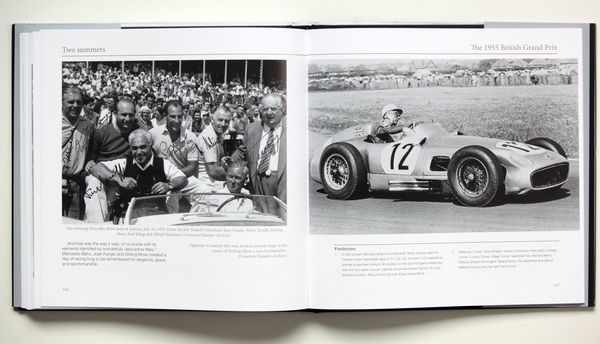
The return of Daimler-Benz to formula racing
Daimler-Benz's return to the premier class of motor racing after the Second World War was a gradual process. In 1951, a delegation was sent to the Temporada in Argentina with three W 154s from 1938-39. The drivers were Juan Manuel Fangio, Karl Kling and Hans Hermann. By the end of the series with two races, it was clear that pre-war technology could no longer be successful.
However, the development department in Untertürkheim still had an ace up its sleeve: the 300 SL (W 194). Developed under Rudolf Uhlenhaut, it already featured key elements that were later incorporated into the monoposto: a tubular frame and the 6-cylinder in-line engine with a displacement of 2,995 cm3, which was installed at an angle to reduce the cross-section of the vehicle.
The W 194 proved to be extremely competitive. With overall victories in the Prize of Berne, the 24 Hours of Le Mans, the Grand Jubilee Prize at the Nürburgring and the Carrera Panamericana, it successfully held its own against various Ferraris, the Aston Martin DB2 and the Jaguar C-type. The Karl Kling/Hans Klenk team also finished second overall in the Mille Miglia.
Based on this experience, the green light was given for the development of a monoposto in 1953. The W 196 R competed in its first race on July 4, 1954 at the French Grand Prix and won with Juan Manuel Fangio at the wheel.
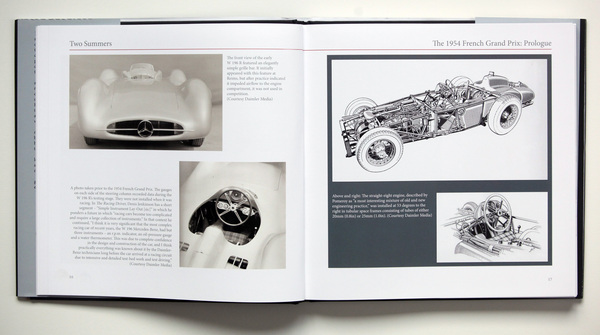
It now had an 8-cylinder in-line engine with a displacement of 2,496 cm3. It was the first racing car ever to have fuel injection. The engine was designed to reach 10,000 rpm and therefore had positive valve timing. To reduce vibrations, it consisted of two four-cylinder engines. The power was taken from the center of the crankshaft. The valve timing via four camshafts was also controlled by gearwheels arranged between the two blocks. The power output was initially specified as 257 hp at 8,250 rpm. In mid-1955, it reached 280 hp at 8,700 rpm.
The drivetrain was of transaxle design and the rear suspension featured a single-joint swing axle with a lowered pivot point, torsion bar suspension and hydraulic telescopic shock absorbers.
Laurence Pomeroy, the English automotive journalist, described the technology as "a most interesting mixture of old and new engineering practice". He was probably alluding to the desmodromic valve timing with two large valves per cylinder, the use of drum brakes and the roller bearings for the connecting rods and crankshaft.
Documented along the timeline
Ackerson meticulously traces the history of the W 196 R's entries in 1954 and 1955. Mercedes-Benz took part in a total of twelve world championship races and won nine of them. Juan Manuel Fangio became world champion of the drivers in both years (there was not yet a constructors' world championship).
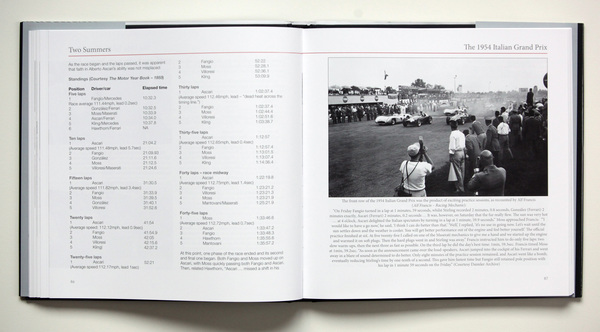
Written by an expert
The author is an expert on the subject. In 2013, he published a book about the W 194 with the same publisher ( Return to Glory! ISBN-13: 978-1-84584-617-6 ) . (Before that, however, he dealt with Chrysler).
His new book stands out in three respects:
- An excellent selection of pictures from the Daimler AG archive.
- For each Grand Prix, a prologue presents the outings of cars from Daimler, Benz and Mercedes-Benz in the preceding period.
- The Silver Arrows' participation in the 1954 Berlin Grand Prix on the AVUS was given its own chapter and documented in the appendix.
Many interesting details
The highlight, however, is that he does not simply provide a summary of the races, but gives the commentators of the time - people like Bernard Cahier, Laurence Pomeroy, Rodney Walkerley, Gregor Grant, Bill Boddy, Denis Jenkinson and others - a chance to have their say. To this end, he quotes from Road & Track, Motor Sport, Autocar, etc.
He has also scoured the various autobiographies for passages that refer to the relevant races. The author takes explanations and background information mostly from articles on the Daimler Global Media website.
It is interesting to see how speculation about the chances of success of the new Silver Arrows changed after the French Grand Prix and how there was talk of a new era in Grand Prix racing. The happy success at the Italian Grand Prix and the defeat at the Spanish Grand Prix (won by Hawthorn in a Ferrari 553 "Squalo") reignited the debate. The first appearances of the Lancia D50 with Ascari, Villoresi and Castellotti at the end of 1954/beginning of 1955 were again the cause of speculation, which, however, came to nothing after the company was taken over by Carlo Pesenti, the racing department was closed and all the material was handed over to Scuderia Ferrari. The D50 would not see its heyday until 1956.
But 1955 was completely dominated by the Mercedes-Benz W 196 R. The highlight was the quadruple victory at the British Grand Prix. The downer was the total failure at the Monaco Grand Prix (the winner was Maurice Trintignant, Ferrari 625).
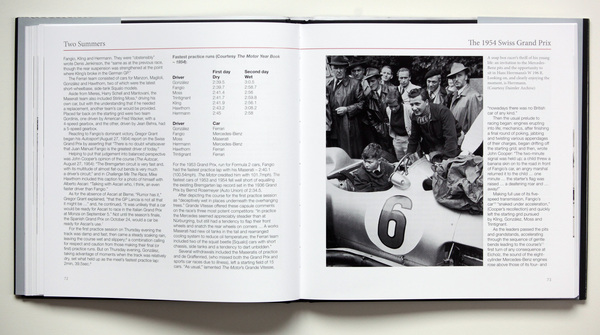
From a Swiss perspective, the coverage of the last Swiss Grand Prix in Bern in 1954 is of course also interesting. John Cooper of Autocar observed a festive atmosphere in the city and pointed out the cars made of chocolate and as sponge cakes in the windows of confectioners, bakeries and patisseries. The larger streets were decorated with colorful flags showing racing cars.
Minor shortcomings
The execution of the book cannot quite keep up. It has various printing errors. In particular, the names and times are repeatedly reproduced incorrectly. Once the caption is wrong (Fangio instead of Moss, page 111). It is also annoying that the starting line-ups and rankings are not consistently documented in the same way for all races. Sometimes they are even missing completely. Although the book thankfully has an index, the entries for the car journalists quoted are missing.
For die-hard fans and beginners
The book is certainly for die-hard Mercedes fans. Some of the photos have rarely, if ever, been shown in publications. In addition, the excerpts from reports in the automotive press and the protagonists' comments from their biographies make for fascinating reading. They make the book truly revealing.
In principle, such a book would also be suitable for a younger audience who are interested in modern motorsport and are not averse to taking a trip into history. The English is easy to read and is not an obstacle, but rather an incentive. It is also available as an e-book. However, at a price of almost 100 euros, it is not cheap to get started.
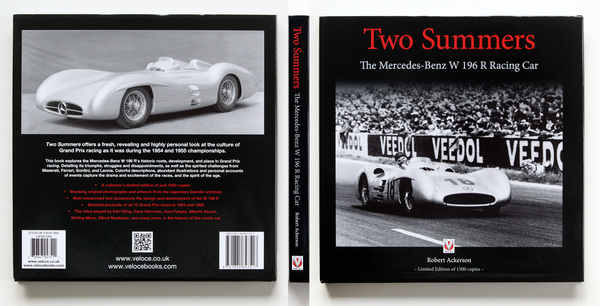
Bibliographical information
- Title: Two Summers: The Mercedes-Benz W 196 R Racing Car
- Author: Robert Ackerson
- Language: English
- Publisher: Veloce Publishing
- Edition: 1st edition 2015 limited to 1'500 copies
- Size/format: hardcover with jacket, 255 x 255 mm, 200 illustrations, 208 pages
- ISBN-13: 978-1-84584-751-7
- Price from the publisher: £ 75.00, from online mail order companies: 99.95 euros (excluding postage/shipping), also available as an e-book
- Buy/order: Online at amazon.co.uk, at Veloce Publishing or in bookstores























